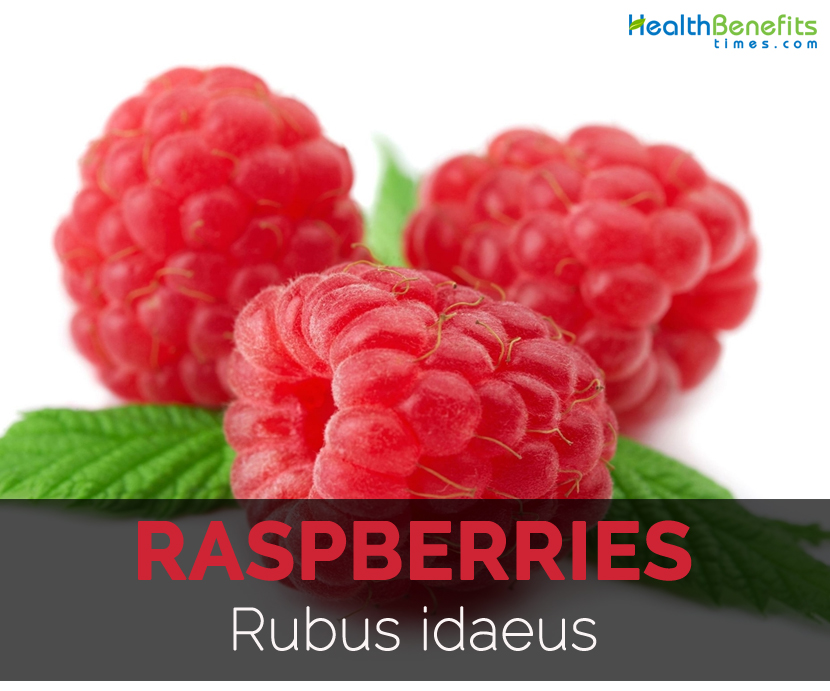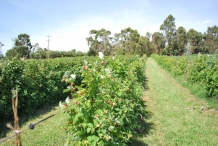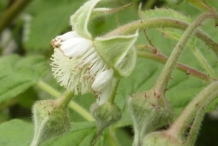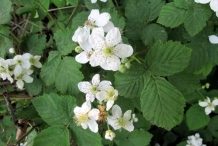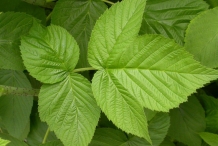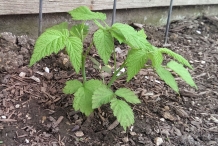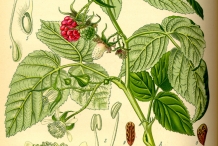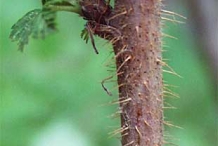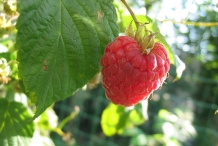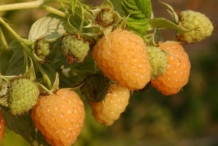Plant
Raspberries are shrubs that can vary in size from 1 to 2 meters in height. The leaves are imparipinnate, ovate or elliptic and 3-8 cm by 1.5-4.5 cm. The flowers have five white petals, spatulate, glabrous or puberulous and 1-1.5 cm across. The fruit is a berry subglobose, rounded and 1.5-2.5 cm across. They have sweet taste but tangy flavor. The fruit contains small seeds. Raspberries bushes typically flowers from June to August. The unbranched stems are woody, rounded, erect, red, biennial and 1.5-2.5 m (5.0-8.3 ft.). The plant prefers well drained, fertile and loamy soil. The red fruit has sweet and tangy taste.
History
Raspberry was firstly cultivated by the ancient Greeks. The harvest of Raspberry was firstly recorded in AD 45 from Mt. Ida. Some people believed that it was actually originated in the Ide Mountains in Turkey. The people of Troy of Mt.Ida gathered the fruits around time of Christ. The domestication was recorded in the 4th century. The seeds were identified in Britain at Roman forts. It was Romans who spread the cultivation of Raspberry throughout the Europe. About 415 varieties was available by 1925 and thousands of Raspberries was cultivated in the Northeastern United States.
During Medieval Europe, the wild berries are used for the medicinal and practical purposes. The juice was used in the illuminated manuscripts and paintings. Kind Edward I is considered as the first person to command for cultivating berries. In the 18th century, the gardens of British were prosperous with the berry bushes and berries. The cultivation of berry reached Europe in the 18th century. When the Europe settlers reached America, they noticed that Native Americans have started the utilization and consumption of berries. They also preserve the berries by drying. The cultivated Raspberries were brought by the settlers to the new colonies. William Price sold the first commercial nursery plants in 1771.
George Washington cultivated the berries in Mount Vernon in 1761. More than 40 varieties were known by 1867. The production took place majorly after the Civil war in the Michigan, New York, Oregon, Pennsylvania, Washington, Ohio, Indiana and Illinois. Almost 2000 acres of Raspberries was cultivated by the 1880. Washington, California and Oregon is considered as the highest producers of red Raspberries. More than 70 million pounds are cultivated on 9600 acres in a year. About 70% of U.S is used for the cultivation of red raspberries.
Nutritional value
The serving size of 123 grams provides 105.47 grams of moisture, 64 calories, 1.48 grams of protein, 0.8 grams of lipid fat, 0.57 grams of ash, 14.69 grams of carbohydrate, 8 grams of dietary fiber, 5.44 grams of total sugars, 5.44 grams of total sugars, 0.25 grams of sucrose, 2.29 grams of glucose and 2.89 grams of fructose. It grants 35.83% of Manganese, 35.78% of Vitamin C, 21.05% of Total dietary fiber, 12.33% of Copper, 11.30% of Carbohydrate and 10.63% of Iron.
Health Benefits of Raspberries
Though Raspberries are not well known like blueberries, it also possesses enormous health benefits. They are rich in antioxidants, dietary fiber and vitamins. It is a great source of ellagic acid which prevents the development of cancer cells and also lowers the chances of cancer. In addition, Raspberries possess high amount of Vitamin C, Vitamin B, folate, folic acid, niacin, iron, potassium, copper and magnesium. Raspberries also possess anthocyanins, pelargonidins, gallic acid, ellagic acid, cyanidins, catechins, kaempferol and salicylic acid.
- Loses weight
Raspberries are rich in manganese and dietary fiber. Fiber helps to delay the digestive process so that one would feel full for long period of time. Manganese helps to maintain high metabolic rate and also burns the fat. Raspberry helps the one to lose the weight effectively.
- Diminish wrinkles
Raspberries could be used as a facial mask and prevent the sun from the rays of sun. The antioxidant properties of Vitamin C help to reduce the appearance of discoloration and age spots. It provides the youthful appearance by filling up the minor wrinkles. One should use the mixture of 2 cups of fresh raspberries and 1 cup of plain yogurt as a face mask for glowing skin. This mixture should be applied to the face and kept for about 15 minutes. Then it should be washed with tepid water.
- Macular degeneration
Macular degeneration could be treated with the three servings of Raspberries in a day. Macular degeneration is the age related illness which affects the vision of a person. It could be in both wet and dry forms. Raspberries should be added to the lunchtime yogurt and morning cereal. The handful of Raspberries could be added balsamic vinegar to alter a taste. The frozen Raspberries could be added vanilla soy milk and spoonful of honey which should be freeze for about 20 minutes. Mint could be used as a garnish.
- Prevent cancer
Raspberries are a great source of antioxidants and ellagic acid. They prevent the damage of cell membranes caused by the free radicals. Raspberries contain the phytonutrients such as ellagic acid, quercetin, kaempferol and cyaniding. Raspberries get the red rich color due to the broken down of flavonoid molecules into anthocyanins. It reduces the growth of fungi and bacteria in the body which could lead to the vaginal infection and results irritable bowel syndrome. The studies show that Raspberries possess anticancer properties. Raspberries are able to prevent the proliferation of cancer cells and development of tumors in the body parts such as colon. (1) (2)
- Overall health
Blackberries, raspberries and muscadine grapes possess metalloproteinase enzymes which is required for the renovation and development of tissues. The abnormal production in excessive amounts leads to the development of cancer. It is rich in riboflavin, Vitamin C, magnesium, niacin, manganese, copper and potassium. Raspberries help to maintain the overall health prosperity.
- Feminine health
Raspberries are good for the women, lactating mothers and pregnant women. The leaves of Raspberry are used as a tea helps to regulate the menstrual cycles and reduce the heavy menstrual flows. Raspberry tea for pregnant women helps to prevent the hemorrhage, nausea, lower pain and assist childbirth. The fruit or Raspberry tea helps to increase the breast milk production.
- Enhance immunity
Raspberries are high in antioxidants and phytonutrients. This helps to enhance the immune system which assists the body to counteract the diseases. (3)
- Rich in nutrients
Raspberries are an excellent source of nutrients such as Vitamin B, antioxidants, Vitamin C and manganese. These antioxidants prevent the body’s tissue against oxygen related damage. Raspberries are a great source of niacin, riboflavin, magnesium, folate, copper and potassium. They are an excellent source of dietary fiber. The nutrients found in Raspberries have insignificant effect on the level of blood sugar.
https://www.youtube.com/watch?v=a9pOlHKbPMY
Traditional uses
- The fruit is regarded to possess antiscorbutic and diuretic properties.
- The Raspberry juice is used with honey to cure fever.
- A face mask of fruit is used to eradicate the skin redness.
- The tea made with leaves of Red Raspberry is used to cure diarrhea, wounds, colic pain and uterine.
- An infusion made from leaves is used as a tonic to calm the labor pains and also provide relief from dsysmenorrhea.
- The leaf and root extracts are regarded as anti-inflammatory, decongestant, astringent, oxytocic, ophthalmic and stimulant agent.
- The extracts of leaf and root are used to gargle in the cause of mouth inflammations and tonsillitis.
- It is used as a wash to cure sores, minor wounds, conjunctivitis, scalds, burns and varicose ulcers.
- An antioxidant properties found in Raspberries helps to eliminate the colon and stomach cancer cells.
- The fruits of Raspberry fruit also help to maintain the liver health.
- The tea made from leaves helps to provide relief from painful menstrual cramps.
- The fruit is used to clean wounds.
- The syrup of Raspberry syrup is an aid for heart disease.
- In Tibet, Raspberries are used to cure exhaustion, irritability and infections.
- Raspberries are used by an ancient Greeks and Romans as hair dye to look more youthful.
- The leaves are used in Ayurvedic medicine with other herbs to make a decoction named kasaya. This increases clarity, mouth stiffening and provides the feeling of heaviness.
- Raspberries are used in China to enhance the liver and kidneys.
- The decoction made from raspberries helps to treat menstrual pain, morning sickness and flu.
- In Europe, the bruised flowers are mixed with honey to treat fever, eye inflammations and boils.
- It is used as a tonic to stimulate the uterus and pelvic muscles.
- The decoction was used by Ojibwa to treat bowel complaints in the children.
- The leaves of Raspberry are dried and used as tinctures.
- The tea made from Raspberry leaf is effective during parturition.
- Eclectics used the leaf decoction to overcome nausea as well as vomiting.
- In France, the leaves are used as a tonic for prostate gland.
Precautions
- The wilted leaves should be avoided because it possesses harmful cyanide.
- The dried Raspberry leaves should be used otherwise it may cause nausea due to the presence of toxins.
- During pregnancy, the high dose of the leaves should be avoided because it can vitalize the uterus.
- The excessive use of Raspberries may cause diarrhea.
- It might cause allergic reactions in some people.
- When the contractions in pregnancy increase, one should discontinue its use.
How to Eat
- Fruits are consumed raw or cooked.
- The fruits are used in pies and preserves.
- Root is cooked or boiled.
- The young shoots are cooked like an asparagus.
- The dried leaves are used to make herb tea.
- In France, Framboise is made by fermenting the raspberries.
- The Thompson Indians use Raspberries to make cakes from the dried and steamed berries.
- The Tanana and Inupiat Inuits use the fruit to make pudding.
- In England, the roots are consumed like turnips.
- Raspberries are also served with ice cream or cream.
- It is also used to make tarts, trifles and cheesecakes.
- Raspberries are used to make preserves.
- They are added to candies, pies and dairy products to enhance flavor.
- Red raspberries are frozen, purée, juice and canned.
- Fruits are used to make jams, jellies, marmalade and liqueur.
- Dried fruit is used in various grocery products.
- Fruits are added to ice-cream.
- Dried leaves are used to make tea.
Other Facts
- Vitamin C is high in Raspberries in comparison to oranges.
- The intake of tea made with Raspberry leaf reduces the second stage of labor.
- They are consumed since prehistoric times but were cultivated in France and England in 1600s.
- Raspberries can be found in purple, red, gold and black in color.
- Raspberry and blackberry belongs to the same plant family.
- Raspberries are considered as the sweetest variety.
- As Raspberries are delicate, it should be consumed within few days.
- Though there are above 200 species of Raspberries, only two species are cultivated commercially.
- Raspberries do not ripen once it is picked from plant.
- In Eastern Asia, Raspberries are used to treat sore throat and used as teeth cleaner.
- Hundreds of Raspberries are produced in a plant per year.
- Raspberry roots survive up to 10 years.
- Russia produces 125.000 tons of Raspberries in a year so it is considered as the largest manufacturer of Raspberries in the world.
Types of Raspberries
Raspberries are renowned for its tiny and sweet berries with an extreme taste. These Raspberries berries are of various types but most of the people are well known to the red ones. Various types of Raspberries taste differently.
1. Red raspberries:
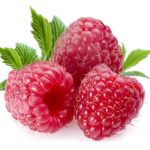 it is a member of the rose family which is made up of small sized fruits each bearing a seed. The centers of red raspberries are empty. Marc Lesarbot, the French lawyer has noted the native red American raspberry in 1607. Raspberries does not have long time period even under refrigeration. The berries with an abundant deep red color should be bought. It should be washed before consumption.
it is a member of the rose family which is made up of small sized fruits each bearing a seed. The centers of red raspberries are empty. Marc Lesarbot, the French lawyer has noted the native red American raspberry in 1607. Raspberries does not have long time period even under refrigeration. The berries with an abundant deep red color should be bought. It should be washed before consumption.
2. Black Raspberries:
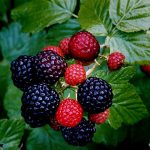 Black Raspberry are native to the Eastern North America. Black Raspberry is closely related to the Western American varieties known as Rubus leucodermis. Black raspberries are loaded with an anthocyanins. It is used as natural dyes. Anthocyanins are the powerful anti-oxidants with nutraceutical value. it is used as an aid for cancer such as esophagea cancer.
Black Raspberry are native to the Eastern North America. Black Raspberry is closely related to the Western American varieties known as Rubus leucodermis. Black raspberries are loaded with an anthocyanins. It is used as natural dyes. Anthocyanins are the powerful anti-oxidants with nutraceutical value. it is used as an aid for cancer such as esophagea cancer.
3. Golden or yellow Raspberries:
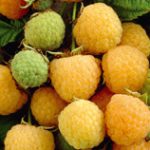 Golden raspberry is natural form of red raspberry which has sweet and moderate taste with pale yellow to orange to gold color. These berries are not common in comparison to others. The fruits might be dark orange to straw yellow when developed fully.
Golden raspberry is natural form of red raspberry which has sweet and moderate taste with pale yellow to orange to gold color. These berries are not common in comparison to others. The fruits might be dark orange to straw yellow when developed fully.
4. Purple Raspberry
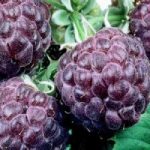 Purple Raspberry is one of the mostly cultivated raspberries which are the hybrids of red and black raspberries.
Purple Raspberry is one of the mostly cultivated raspberries which are the hybrids of red and black raspberries.
Nearly all the Raspberries are classified into two classes such as:
- Ever Bearing or Fall Bearing
- Summer Bearing
References:
https://plants.usda.gov/plantguide/pdf/cs_ruid.pdf
http://www.ndhealthfacts.org/wiki/Rubus_idaeus
http://www.botanical.com/botanical/mgmh/r/raspbe05.html
https://www.drugs.com/npc/raspberry.html
http://www.anniesremedy.com/herb_detail111.php
http://www.encyclopedia.com/topic/raspberry.aspx
http://www.herballegacy.com/Corless_History.html
http://www.voyageurcountry.com/htmls/floweringplants/plants/raspberry.html
http://www.bbcgoodfood.com/glossary/raspberry
http://www.telegraph.co.uk/gardening/11761546/12-things-you-didnt-know-about-raspberries.html
http://servingjoy.com/fun-facts-of-raspberries/
https://www.organicfacts.net/health-benefits/fruit/health-benefits-of-raspberry.html
Comments
| Raspberries Quick Facts | |
|---|---|
| Name: | Raspberries |
| Scientific Name: | Rubus idaeus |
| Origin | Native to Europe and Northern Asia, Russia and Central Asia. |
| Colors | Red (Fruit) |
| Shapes | Subglobose, rounded; Across: 1.5-2.5 cm (Fruit) |
| Flesh colors | Red |
| Taste | Sweet |
| Calories | 64 Kcal./cup |
| Major nutrients | Manganese (35.83%) Vitamin C (35.78%) Total dietary Fiber (21.05%) Copper (12.33%) Carbohydrate (11.30%) |
| Health benefits | Loses weight, Diminish wrinkles, Macular degeneration, Prevent cancer, Overall health |
| More facts about Raspberries | |
| Rank | Scientific Name & (Common Name) |
|---|---|
| Kingdom | Plantae (Plants) |
| Subkingdom | Tracheobionta (Vascular plants) |
| Superdivision | Spermatophyta (Seed plants) |
| Division | Magnoliophyta (Flowering plants) |
| Class | Magnoliopsida (Dicotyledons) |
| Subclass | Rosidae |
| Order | Rosales |
| Family | Rosaceae (Rose family) |
| Genus | Rubus L. (Blackberry) |
| Species | Rubus idaeus L. (American red raspberry) |


